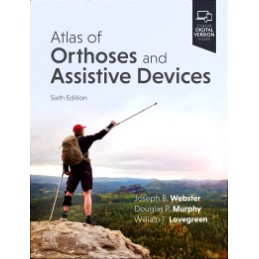- Obniżka
- Nowy


 Dostawa
Dostawa
Wybierz Paczkomat Inpost, Orlen Paczkę, DHL, DPD, Pocztę, email (dla ebooków). Kliknij po więcej
 Płatność
Płatność
Zapłać szybkim przelewem, kartą płatniczą lub za pobraniem. Kliknij po więcej szczegółów
 Zwroty
Zwroty
Jeżeli jesteś konsumentem możesz zwrócić towar w ciągu 14 dni*. Kliknij po więcej szczegółów
Opis
SECTION 1 Basics
1. Orthotic Prescription
2. Materials Science
3. Principles of Fabrication
4. Digital Technology in Orthotics and Prosthetics
5. Principles of Normal and Pathologic Gait
SECTION 2 Spinal Orthoses
6. Biomechanics of the Spine
7. Principles and Components of Spinal Orthoses
8. Orthoses for Spinal Pain
9. Orthoses for Spinal Deformities
10. Orthoses for Spinal Trauma and Postoperative Care
11. Orthoses for Osteoporosis
SECTION 3 Upper Limb Orthoses
12. Biomechanics of the Upper Limb
13. Principles and Components of Upper Limb Orthoses
14. Upper Limb Orthoses for Persons with Stroke and Brain Injury
15. Upper Limb Orthoses for Persons with Spinal Cord Injuries and Brachial Plexus Injuries
16. Orthoses for the Burned Hand
17. Orthotic Treatment Considerations for Arthritis and Overuse Syndromes in the Upper Limb
18. Functional Bracing of Selected Upper Limb Fractures
SECTION 4 Lower Limb Orthoses
19. Biomechanics of the Hip, Knee, and Ankle
20. Foot Biomechanics
21. Shoes and Shoe Modifications
22. Foot Orthoses
23. Lower Limb Orthoses
24. Lower Limb Orthoses for Persons with Spinal Cord Injury
25. Orthoses in Total Joint Arthroplasty
26. Knee Orthoses for Sports-Related Issues
27. Orthotic Management of Neuropathic and Dysvascular Feet
28. Orthotic Management of Polio and Postpolio Syndrome
29. Lower Limb Orthoses for Persons Who Have Had a Stroke
30. Assessment and Orthotic Management of Gait Dysfunction in Individuals with Traumatic Brain Injury
SECTION 5 Pediatric Orthoses
31. Congenital and Acquired Disorders
32. Pediatric Hip Orthoses
33. Orthoses for Patients with Muscle Disease
34. Orthoses for Cerebral Palsy
35. Orthoses for Myelomeningocele
36. Cranial Remolding Orthoses
SECTION 6 Assistive Devices
37. Canes, Crutches, and Walkers
38. Wheeled Mobility: Evaluation for Orthotic Seating and Positioning
39. Wheeled Mobility: Device Prescription and Care
40. Orthotic Management Considerations for Resource-Limited and Remote Settings
41. Communication Devices and Electronic Aids to Activities of Daily Living
42. Sports Adaptations and Assistive Devices for Recreation
43. Driving and Related Assistive Devices
44. Neuroprosthetic Applications
45. Exoskeletal-Assisted Rehabilitation After Spinal Cord Injury
46. Future Trends and Research in Orthoses
Indeks: 66096
Autor: Andreas Heinrich Tiemann
